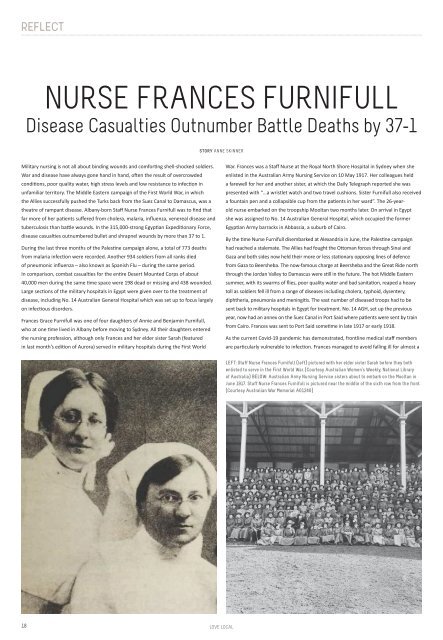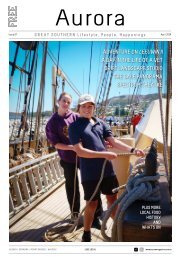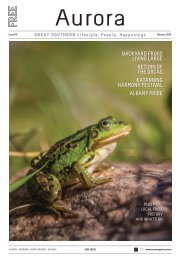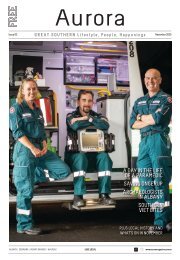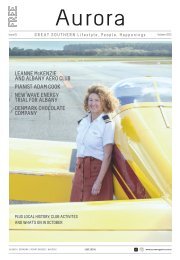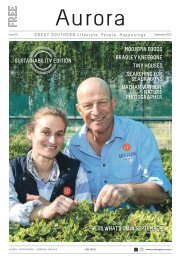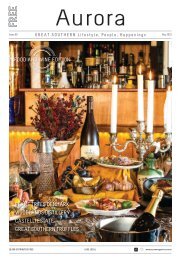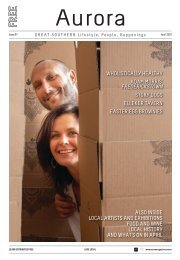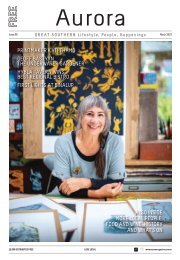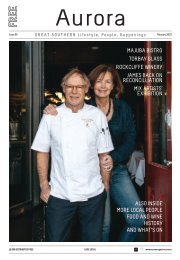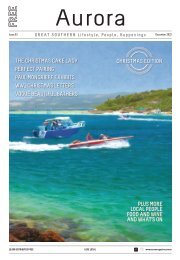Issue 37 Aurora Magazine April 2021
Great Southern People, Lifestyle, Happenings
Great Southern People, Lifestyle, Happenings
- No tags were found...
You also want an ePaper? Increase the reach of your titles
YUMPU automatically turns print PDFs into web optimized ePapers that Google loves.
eflect<br />
NURSE FRANCES FURNIFULL<br />
Disease Casualties Outnumber Battle Deaths by <strong>37</strong>-1<br />
STORY ANNE SKINNER<br />
Military nursing is not all about binding wounds and comforting shell-shocked soldiers.<br />
War and disease have always gone hand in hand, often the result of overcrowded<br />
conditions, poor quality water, high stress levels and low resistance to infection in<br />
unfamiliar territory. The Middle Eastern campaign of the First World War, in which<br />
the Allies successfully pushed the Turks back from the Suez Canal to Damascus, was a<br />
theatre of rampant disease. Albany-born Staff Nurse Frances Furnifull was to find that<br />
far more of her patients suffered from cholera, malaria, influenza, venereal disease and<br />
tuberculosis than battle wounds. In the 315,000-strong Egyptian Expeditionary Force,<br />
disease casualties outnumbered bullet and shrapnel wounds by more than <strong>37</strong> to 1.<br />
During the last three months of the Palestine campaign alone, a total of 773 deaths<br />
from malaria infection were recorded. Another 934 soldiers from all ranks died<br />
of pneumonic influenza – also known as Spanish Flu – during the same period.<br />
In comparison, combat casualties for the entire Desert Mounted Corps of about<br />
40,000 men during the same time space were 198 dead or missing and 438 wounded.<br />
Large sections of the military hospitals in Egypt were given over to the treatment of<br />
disease, including No. 14 Australian General Hospital which was set up to focus largely<br />
on infectious disorders.<br />
Frances Grace Furnifull was one of four daughters of Annie and Benjamin Furnifull,<br />
who at one time lived in Albany before moving to Sydney. All their daughters entered<br />
the nursing profession, although only Frances and her elder sister Sarah (featured<br />
in last month’s edition of <strong>Aurora</strong>) served in military hospitals during the First World<br />
War. Frances was a Staff Nurse at the Royal North Shore Hospital in Sydney when she<br />
enlisted in the Australian Army Nursing Service on 10 May 1917. Her colleagues held<br />
a farewell for her and another sister, at which the Daily Telegraph reported she was<br />
presented with “…a wristlet watch and two travel cushions. Sister Furnifull also received<br />
a fountain pen and a collapsible cup from the patients in her ward”. The 26-yearold<br />
nurse embarked on the troopship Mooltan two months later. On arrival in Egypt<br />
she was assigned to No. 14 Australian General Hospital, which occupied the former<br />
Egyptian Army barracks in Abbassia, a suburb of Cairo.<br />
By the time Nurse Furnifull disembarked at Alexandria in June, the Palestine campaign<br />
had reached a stalemate. The Allies had fought the Ottoman forces through Sinai and<br />
Gaza and both sides now held their more or less stationary opposing lines of defence<br />
from Gaza to Beersheba. The now-famous charge at Beersheba and the Great Ride north<br />
through the Jordan Valley to Damascus were still in the future. The hot Middle Eastern<br />
summer, with its swarms of flies, poor quality water and bad sanitation, reaped a heavy<br />
toll as soldiers fell ill from a range of diseases including cholera, typhoid, dysentery,<br />
diphtheria, pneumonia and meningitis. The vast number of diseased troops had to be<br />
sent back to military hospitals in Egypt for treatment. No. 14 AGH, set up the previous<br />
year, now had an annex on the Suez Canal in Port Said where patients were sent by train<br />
from Cairo. Frances was sent to Port Said sometime in late 1917 or early 1918.<br />
As the current Covid-19 pandemic has demonstrated, frontline medical staff members<br />
are particularly vulnerable to infection. Frances managed to avoid falling ill for almost a<br />
LEFT: Staff Nurse Frances Furnifull (left) pictured with her elder sister Sarah before they both<br />
enlisted to serve in the First World War. (Courtesy Australian Women’s Weekly, National Library<br />
of Australia) BELOW: Australian Army Nursing Service sisters about to embark on the Mooltan in<br />
June 1917. Staff Nurse Frances Furnifull is pictured near the middle of the sixth row from the front.<br />
(Courtesy Australian War Memorial A01240)<br />
18 LOVE LOCAL<br />
<strong>Aurora</strong>_0<strong>37</strong>_<strong>April</strong> <strong>2021</strong>.indd 18<br />
23/3/21 8:09 pm


